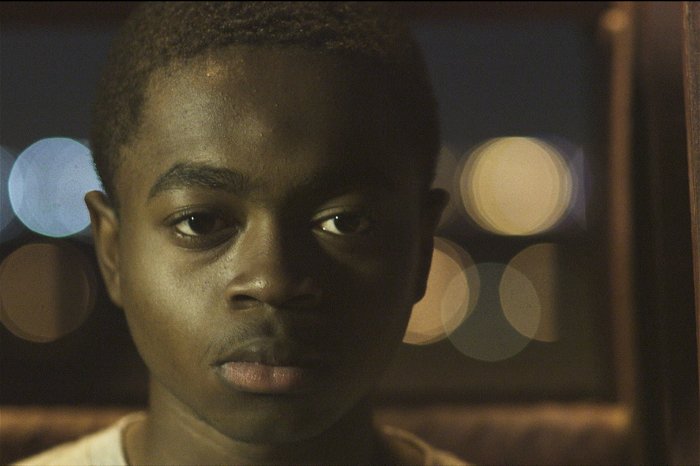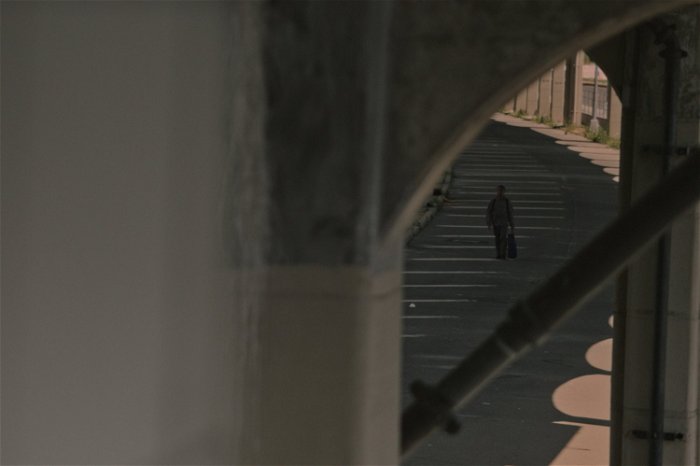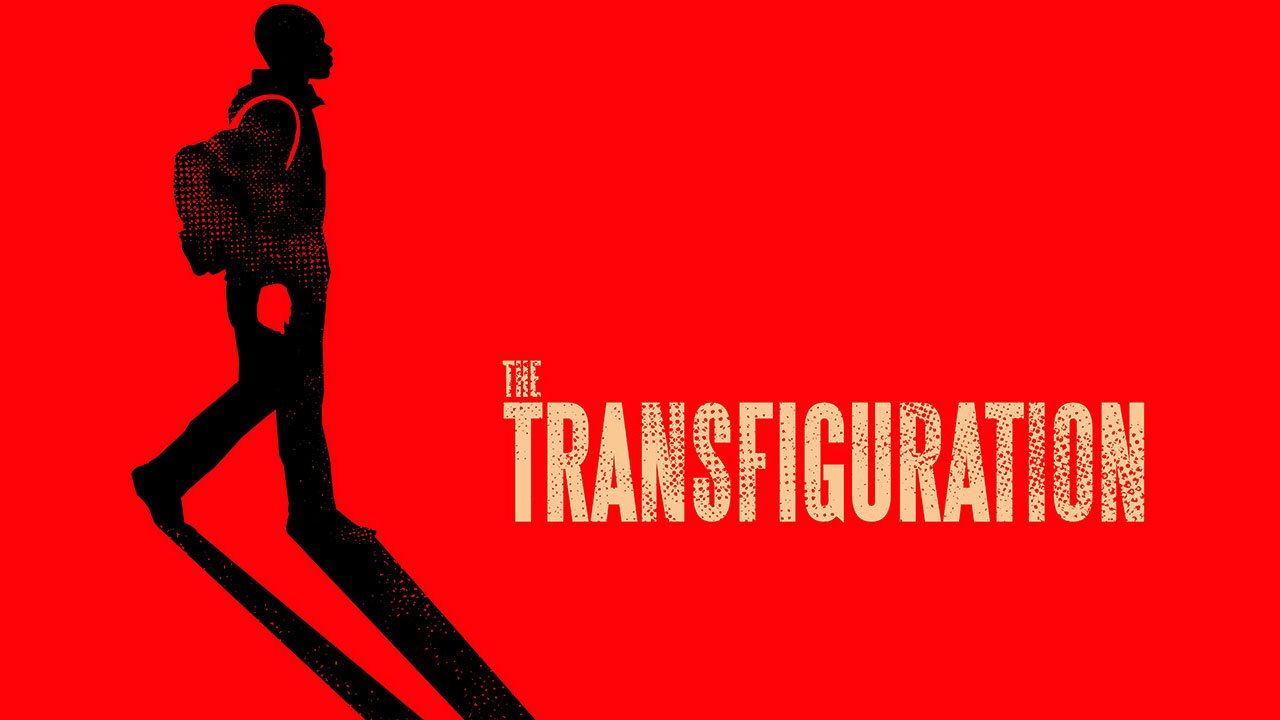The horror genre is often derided for the ways in which it too often relies on formula and cheap scares to stimulate viewers’ spooky centres. Thankfully, that’s far from always the case. This week, the oddball indie art horror film Transfiguration comes to Toronto, and it hardly conforms to genre norms. Eric Ruffin stars as Milo, a dejected teen struggling through a rough existence in New York housing projects. His escape from the horrors of his regular life are the stylized horrors he experiences through genre movies. Specifically, Milo adores vampire flicks.
In fact, he’s begun to think that he’s a vampire, and has even started stalking and possibly even feasting on blood to satisfy his fantasy. His life is shaken up when he meets Sophie (Chloe Levine), an equally lost soul who bounds with Milo over a shared love of horror and then bonds even more deeply. There’s a chance that finding a genuine human connection might be enough for the lost kid to give up his vampire obsession or maybe it just might fuel it further.
The debut feature by writer/director Michael O’Shea is a thrilling love letter to the horror genre and a poignant exploration of brutal teenage alienation. The film was a hit at Cannes last year where the mixture of knowing horror tropes and an empathetic exploration of the traumas of youth went over like gangbusters. Since then, O’Shea has been touring around with the film, getting critical adoration wherever he goes. It’s a remarkably accomplished first feature, both achingly human and disturbingly stylized.

O’Shea is a clear student of horror, layering his film with horror references from overt dialogue debates and clips of classics (like the conveniently public domain Nosferatu) to cameos from the likes of indie genre legends Larry Fessenden (Habit, Wendigo) and Lloyd Kauffman (Troma Films), or the fact that the whole thing could be considered an homage to George A. Romero’s underrated Martin. Yet, it’s also a painfully personal and human tale, weaved within all the scares and gonzo low budget filmmaking techniques (it was shot on location in New York, typically without permission. God bless them). Transfiguration is a pleasant genre surprise that should please those with a sweet tooth for horror and a heart for art.
CGMagazine got a chance to chat with Michael O’Shea during a visit to Toronto to screen his delightful directorial debut, so we took the opportunity to geek out about our shared love of the genre and the unconventional techniques he used to create Transfiguration.
CGMagazine: So first up, can I assume you are a fan of George A. Romero’s Martin?
Michael O’Shea: (Laughs) Yep. You can indeed assume that. I’m a big fan of Martin. We tried to get John Amplas who plays Martin to play Sophie’s grandfather for a scene. We cold emailed him like we cold emailed everyone. We tried to stunt cast that role with a few different 70s guys, including that “Warriors come out to play” guy, but he turned us down. The first cut of the movie was two hours and twenty minutes long, and we cut in down to ninety minutes. In cutting an hour of the movie out, I didn’t want to change the pace. We wanted a slow methodical pace. So we had to lift entire scenes out and that scene got cut. So it’s lucky we didn’t get him. But yes, I wanted to get Martin to play the grandfather as a shout out because obviously, I love that movie.
CGM: Yeah and you certainly didn’t shy away from horror movie references in general.
O’Shea: (Laughs) Oh yeah. I love horror and I love the idea that when you’re seeing a horror movie all these stories come before it, and overtly referencing that is cool. I love referencing other movies. I remember when I showed someone the script they said, “I don’t like it because you do all this referencing…when you use pop culture references like that, you date your movie.” But I don’t know. I like that stuff. I like the idea of using other people’s stuff and ideas, mish-mashing it together and using it to make your own stew. That’s particularly resonant in horror because as fans, we’re all familiar with the mechanics of the genre and what happens, whether it’s a slasher or a vampire film. As someone who really likes this idea of taking other creative things and mixing them all together, I was really attracted to including nods to the horror myths that came before me.

CGM: I liked how your movie commented on how horror appeals specifically to outsiders and those who feel alienated. Was that part of how this entire project began for you?
O’Shea: Once I realized that I was writing about a teenager, then suddenly all my teenage sh** came out. When I was a teenager, I was obsessed with horror movies and that was part of my escape from my hometown, and also how I connected with the few other kids like me. Like the kid who showed me Faces Of Death when I was in the eighth grade, which is in the movie. I guess that’s all done through YouTube now. A very different thing, we used to have to trade VHS tapes of Faces of Death.
CGM: Yeah, you don’t even have to look anyone in the eye when you make them watch Faces of Death anymore.
O’Shea: (Laughs) So yeah, all of my feelings of being an outsider growing up all came out when I realized this was going to be a teen movie. I first started writing horror about ten years ago. I wrote a slasher movie first, and I immediately was brought back to being a teenager. That’s when it hit me the most. I had issues of Fangoria all over my wall. I was so sad when I found out last year that Fangoria went away. I realized that there will never be an article on Transfiguration in Fangoria, and I was so sad. So anyways, all my baggage of being a teenager came out in this script. I hate the idea that people think that him watching all these horror movies and videos were what made him become violent. All interpretations of the movie are valid, but that really wasn’t my intent! (Laughs) I love horror and in no way would I ever suggest that it’s horror’s fault. Horror is how he escapes and honestly, his belief that he’s a vampire is what makes him a noble creature. Horror helps!
CGM: I enjoyed the way Milo had his own interpretation of what makes him a vampire and what makes vampire’s “real.” He never really lays it out in the movie though. Did you have that list of rules for yourself and the cast?
O’Shea: I don’t think I gave it to anyone in the cast, but I wrote his timeline early on and I wrote his notebooks early on, which have all his rules in them. But the rules were sort of a confirmation bias. He starts with the notion that he’s becoming a vampire. So after that every rule he sees that applies to him about vampire must be true, and everything that doesn’t apply to him must be false about vampires. So his rules all come from that prism. You start from a conclusion that could be false, which is “I am a vampire.” So, if I can’t climb walls then Let the Right One In must be false because she can climb walls, and I can’t do that. So I did come up with all that, and wrote it out in his journal pages. My lookbook which I did to sell the movie was basically all his journal pages. I wrote out all of his rules for hunting and everything else out. I love that in the age of Wikipedia, he doesn’t really have to do all that. All the rules are on Wikipedia, so he doesn’t really have to write them all out. He’s just compelled to. He’s an exhaustive guy, so he wouldn’t trust the Wikipedia page. But it’s out there.

CGM: With this being your first film, was there any apprehension on your part to make a horror movie that was so unconventional right out of the gate?
O’Shea: No, I wanted to try for a home run. The thing is that it may be my only film too. I think when I was 22 I may have played it safe. But since I’m 44, I thought this could be my only chance and I wanted to do everything that I’d ever wanted to do. My girlfriend was the producer, and she’s produced many other films. So I really trusted her to stop me from being too masturbatory, or too “student-filmy,” or too out of line. So since I had her, I felt free to go out as far as I wanted knowing that she would always slap me back down to earth if I wanted to do something that would lose the audience. The slasher movie that I wrote before this was an attempt to do something more mainstream, but that didn’t get any money. So then I decided to try for something cheaper and weirder. The slasher movie is still a little weird, but it’s not quite as weird as this one.
CGM: I love that you shot live on the streets of New York with real people in the background. It has an effect that’s hard to deny, like an old Larry Cohen movie—
O’Shea: Yeah exactly!
So how was that experience?
O’Shea: Well, the actors grew to hate it. In interviews, the actors have been very polite and said it helped them get into character, but on set they weren’t quite so happy (Laughs). We shot out the apartment in a week on a closed set, and then we through Eric out in the street and made him do a long monologue while crossing an actual street with traffic, and he was not thrilled (Laughs). The biggest problem is people responding when you don’t hide the camera. I like the idea of shooting across the street on long lenses, but it doesn’t always get the right shot. That’s the biggest problem with live locations is that people notice and look in the camera.
So we shot with a small crew, maybe three people around a small camera that looks like a prosumer camera. Then you hide the rest of the crew in a van down the block and hope that no one notices. That’s what ruins takes more than anything else. The hardest one was that movie theatre scene, those were all real store and I loved how they looked and felt, but people were going in and out of the stores and would look right in the lens. Other than that, there weren’t many problems. Part of the legality of shooting live is that the people all have to be in the background. There can never be an interaction with a real human or they have to sign a lot of legal documents. So there was no improvisation with real people.
CGM: I loved the desolate New York locations that you used, which much be harder and harder to find all the time.
O’Shea: They are! That’s why I say it’s sort of a fable. It feels very authentic, but it’s also a bit of a fable because I’m picking specific locations to look like the New York of the 70s and 80s. Luckily I grew up where I shot the movie, so I knew where to find all of those spots. But those lots with nothing in them? There’s little a luxury development being built right next to them. Those were the lots that I played in growing up, empty lots that went on as far as you can see. Those are all being gentrified now, but fortunately, since I grew up there, I knew all the little places left that we could use. I call it “depressed Peanuts.”
CGM: Did you find you had to schedule certain scenes around disappearing locations?
O’Shea: I mean, we were saying that about the whole film period. The lots were so important to me and they were building on them every year that we couldn’t get the money. I don’t mean to sound horrible, but Sandy hit my hometown and that’s why I wanted to shoot there. I am glad they rebuilt it all, but it was tough to see those spots disappearing while we were struggling to finance the movie (Laughs).
CGM: I really enjoyed seeing Larry Fessenden pop up in the movie because this very much felt like the type of off-kilter horror movie that he specializes in. So how did that come about and did he offer any advice?
O’Shea: I know, right? Because of Habit! I was worried about that, just like I’m worried about Romero ever seeing the movie because of Martin. I don’t want them to feel like I’m encroaching on their territory. But he was great. He’s a friend of Susan, my partner and producer. So she’d worked with him before. I knew I was going to either reach out to him about being in the movie or using Habit in the movie. I couldn’t do both because that’s just weird (Laughs).
So, he read the script, and when he showed up he said he loved it and I was so grateful. The shooting day was in a tiny apartment, it was summer, it was 100 degrees, and he was covered in makeup. I felt so bad about it. But no, no, obviously Larry is familiar with low budget filmmaking. It was intimidating for me to work with him that day because he’s such a legend. It was slightly more intimidating than working with Lloyd Kaufman (Laughs). Lloyd I just felt bad because there were no bathrooms on the set that day. We were just in a park, but of course he’s the Troma guy. So I’m sure it wasn’t the first time (Laughs).
CGM: Do you think that you’ll continue to work in horror and push around the boundaries of the genre?
O’Shea: Oh yeah, everything that I write stays in horror, murders people, and messes with the genre. I also have a guy and a girl on the road with a gun movie, which I still consider exploitation. I also have a ghost story, that slasher movie, and I’m writing a possession movie next. They all play with your expectations in the genre. The slasher I’m going to put aside for a while because Green Room did that so well, I don’t want to touch it. So I’m going to keep writing those things, but my agent also sends me scripts, and I would certainly consider doing something more traditional. You know, I want to work (Laughs). I’m probably not going to say, “my scripts or nothing” because I want to work.





